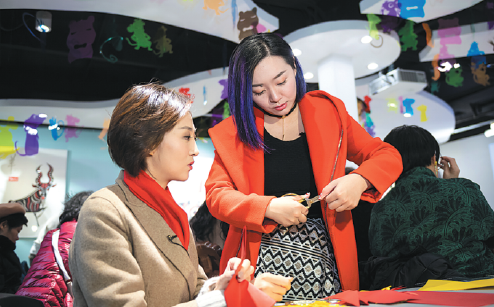
From the People's Daily App.
This is Story in the Story.
Chinese paper-cuts, as the name implies, is an art of cutting out patterns from paper with the help of scissors or a knife.
With a history dating back thousands of years, the art is characterized by intricate designs and the creative use of negative space. The cut-outs can be used to adorn walls, columns, mirrors, windows and doors.
During the Chinese New Year, people attach festive cuttings on doors and windows in an attempt to favor prosperity in the coming year. It is perhaps an important reason why this form of art remains one of the country's highly preserved intangible heritages.
The subject matter of the cuttings can be anything from historical figures and fairytale characters to plants.
In 2009, Chinese paper-cuts were added to the Representative List of the Intangible Cultural Heritage of Humanity.
Today’s Story in the Story looks at the current state of paper-cuts which reached their heyday during the Qing Dynasty (1636-1912).

Li Shiyi instructs a young participant in her paper-cutting course in her studio in Shanghai. (Photo: China Daily)
After folding a piece of red paper in half, Li Shiyi carefully trims off a portion before unfolding the paper to reveal an auspicious design of two mice holding a gourd.
"The mouse is one of the Chinese zodiac animals, and the gourd represents great fortune," says Li.
It takes two minutes to turn an ordinary piece of paper into an outstanding artwork.
Li, 29, is among the few remaining artists of traditional Chinese paper-cutting, an intangible cultural heritage that was first documented by historian Sima Qian 2,000 years ago.
"I want to revive this form of art and popularize it among today's young people," Li says, when asked about her motivations behind choosing this line of work.
"We want to break the stereotype that Chinese paper-cutting is outdated and that its designs are limited to 'double happiness' characters. I teach people to create designs based on their own ideas," she says. "Paper-cutting may be traditional, but it can also be fashionable."
“You can’t forget aesthetics when doing Chinese paper-cuts. This art form was invented for decoration from the very beginning,” said Wang Jianzhong, a famous inheritor of the Chinese paper-cuts, during an interview in Shanghai.
“Before doing Chinese paper-cuts, you have to learn how to study painting. Without good brushwork, you can’t produce good paper-cuts work,” said Fang Jianguo, who has been doing Chinese-cuts for over three decades.

Paper-cuts by Li Shiyi and her father, Li Shoubai, feature cultural icons of Shanghai, such as the shikumen buildings and women in cheongsam. (Photo: China Daily)
Although compared with many other forms of art, Chinese paper-cuts have a relatively stable user base but concerns over passing the art form down still haunt people in the know.
“It’s very probable that I can’t find a successor in my own family. I do hope we can establish some schools to teach students Chinese paper-cuts,” said Wang.
Today, 58-year-old Li Shoubai works on the fifth floor of A-Zenith, a company in Shanghai that specializes in retro-style furniture from 1900s Shanghai.
In a partnership with the company, Li gets to use half of the level as his studio and in return, he helps the company to design furniture and decorative elements.
He learned painting and paper-cutting from his father before leaving the country in the 1990s to work as a painter for a company in Singapore.
During his time in the Southeast Asian country, he developed a passion for painting subjects related to old Shanghai.
Li Shoubai returned to Shanghai after the turn of the millennium and eventually created his own style of painting. He also experimented with blending wood-cutting styles into his paper-cutting creations, which were often of traditional Chinese symbols and modern architecture.
"Through my work, I want to pass on the traditional paper-cutting technique in the context of metropolitan Shanghai," he says.
Li also views his daughter as a means to promote traditional paper-cutting to the world. The father-and-daughter duo have promoted the art form at many international events over the years.
"What we are doing now is making paper-cutting a popular culture again. Paper-cutting art should not be limited to museums or passed down only among inheritors," he says.
(Produced by Nancy Yan Xu, Brian Lowe, Lance Crayon and Paris Yelu Xu. Music by: bensound.com. Text from China Daily and CGTN.)


